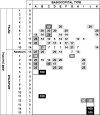Clival canal and clival foramen development in the fetal and infant basioccipital
- PMID: 28540612
- PMCID: PMC5551672
- DOI: 10.1007/s00381-017-3466-2
Clival canal and clival foramen development in the fetal and infant basioccipital
Abstract
Purpose: There is a paucity of research regarding both the development and the prevalence of the clival canal or clival foramen in fetuses. Reports that have examined child and adult populations have posited ideas for the development of the canal and foramen; however, they have done so in the absence of anatomical data from the fetal population. Therefore, the present study was performed to elucidate the development of the clival canal and foramen through the assessment of perinatal basioccipitals.
Methods: This study analyzed 104 basioccipital bones, 60 from fetuses and 44 from newborns and infants. Dorsal surfaces of basioccipitals were assessed for the presence of anatomical variation with particular attention to the presence of clival canals and foramina. Among cases in which the presence of a clival canal or clival foramen was suspected, cannulation was performed for verification.
Results: Of the 104 basioccipitals analyzed, 1 (0.96%) had a clival foramen. Clival canals were identified in seven basioccipitals (7:104; 6.73%), four of which were from fetuses. Trends in anatomical variations among basioccipitals were also identified and categorized. These categories were then evaluated relative to age in order to elucidate ontogeny. A model is presented to explain the development of the clival foramen, the clival canal, and the basioccipital, in general.
Conclusions: The presence of a clival canal or foramen should be considered even among individuals of fetal age. The findings of this osteological study suggest that the clival canal and foramen develop around vascular structures and, therefore, signify vascular connections among nearby venous plexuses.
Keywords: Anatomy; Clivus; Cranial base; Notochord.
Conflict of interest statement
Figures















Similar articles
-
Ontogeny of the human fetal, neonatal, and infantile basioccipital bone: Traditional and extended eigenshape geometric morphometric analysis.Anat Rec (Hoboken). 2022 Nov;305(11):3230-3242. doi: 10.1002/ar.24838. Epub 2021 Dec 1. Anat Rec (Hoboken). 2022. PMID: 34825511 Free PMC article.
-
The Presence of Clival Foramen Through Multidetector Computed Tomography of the Skull Base.J Craniofac Surg. 2015 Oct;26(7):e580-2. doi: 10.1097/SCS.0000000000002129. J Craniofac Surg. 2015. PMID: 26468827
-
The enigmatic clival canal: anatomy and clinical significance.Childs Nerv Syst. 2010 Sep;26(9):1207-10. doi: 10.1007/s00381-010-1100-7. Epub 2010 Mar 6. Childs Nerv Syst. 2010. PMID: 20213190
-
A comprehensive review of the clivus: anatomy, embryology, variants, pathology, and surgical approaches.Childs Nerv Syst. 2018 Aug;34(8):1451-1458. doi: 10.1007/s00381-018-3875-x. Epub 2018 Jun 28. Childs Nerv Syst. 2018. PMID: 29955940 Review.
-
[Posterior cranial fossa skull base tumors (clival, foramen magnum, and jugular foramen tumors)].Ryoikibetsu Shokogun Shirizu. 2000;(28 Pt 3):322-7. Ryoikibetsu Shokogun Shirizu. 2000. PMID: 11043259 Review. Japanese. No abstract available.
Cited by
-
Assessing the morphology and bone mineral density of the immature pars lateralis as an indicator of age.Int J Legal Med. 2024 Mar;138(2):467-486. doi: 10.1007/s00414-023-03085-z. Epub 2023 Sep 29. Int J Legal Med. 2024. PMID: 37775592 Free PMC article.
References
-
- Hemphill M, Freeman JM, Martinez CR, Nager GT, Long DM, Crumrine P. A new, treatable source of recurrent meningitis: basioccipital meningocele. Pediatrics. 1982;70:941–943. - PubMed
-
- Azizkhan RG, Cuenca RE, Powers SK. Transoral repair of a rare basioccipital meningocele in a neonate: case report. Neurosurgery. 1989;25:469–471. - PubMed
-
- Ko AL, Gabikian P, Perkins JA, Gruber DP, Avellino AM. Endoscopic repair of a rare basioccipital meningocele associated with recurrent meningitis. J Neurosurg Pediatr. 2010;6:188–192. - PubMed
-
- Mattei TA, Goulart CR. The clinical importance of basioccipital developmental defects. Childs Nerv Syst. 2012;28:501–504. - PubMed
MeSH terms
Grants and funding
LinkOut - more resources
Full Text Sources
Other Literature Sources

